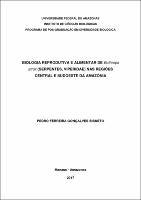| ???jsp.display-item.social.title??? |


|
Please use this identifier to cite or link to this item:
https://tede.ufam.edu.br/handle/tede/5547Full metadata record
| DC Field | Value | Language |
|---|---|---|
| dc.creator | Gonçalves Bisneto, Pedro Ferreira | - |
| dc.creator.Lattes | http://lattes.cnpq.br/9443119243528777 | por |
| dc.contributor.advisor1 | Kaefer, Igor Luis | - |
| dc.contributor.advisor1Lattes | http://lattes.cnpq.br/7592372945105122 | por |
| dc.contributor.referee1 | Bührnheim, Cristina Motta | - |
| dc.contributor.referee2 | Gordo, Marcelo | - |
| dc.contributor.referee3 | Fraga, Rafael de | - |
| dc.date.issued | 2016-08-11 | - |
| dc.identifier.citation | GONÇALVES BISNETO, Pedro Ferreira. Biologia reprodutiva e alimentar de Bothrops atrox (serpentes, viperidae) nas regiões central e sudoeste da Amazônia. 2016. 35 f. Dissertação (Mestrado em Diversidade Biológica) - Universidade Federal do Amazonas, Manaus, 2016. | por |
| dc.identifier.uri | http://tede.ufam.edu.br/handle/tede/5547 | - |
| dc.description.resumo | A jararaca Bothrops atrox é uma serpente de ampla distribuição e localmente abundante na Amazônia. Visto que a biologia reprodutiva e alimentar de serpentes varia geograficamente, objetivamos caracterizar a história natural de indivíduos provenientes das porções central e sudoeste do bioma. Para isso, analisamos espécimes preservados coletados na área compreendida entre as regiões metropolitanas dos municípios brasileiros de Manaus e Porto Velho. Foram aferidas medidas morfométricas e realizadas análises gonadais e do trato digestório de 109 exemplares. Fêmeas atingem a maturação sexual com tamanhos corporais maiores. Adultos da espécie apresentam marcado dimorfismo sexual em tamanho, sendo que fêmeas são, em média, maiores. O ciclo reprodutivo parece estar sincronizado com o regime de chuvas regional, o qual difere daquele encontrado em outras porções do bioma. A espécie possui dieta generalista, com a ingestão de uma ampla gama de presas tais como lacraias, anuros, lagartos, serpentes e mamíferos. Neste estudo foi registrada pela primeira vez a predação da serpente Imantodes cenchoa (Dipsadidae) por B. atrox. Há mudança ontogenética na dieta: indivíduos menores se alimentam principalmente de presas ectotérmicas (lacraias, anuros, lagartos e serpentes) e adultos tendem a incorporar itens endotérmicos (mamíferos) ao repertório alimentar. | por |
| dc.description.abstract | The pit viper Bothrops atrox is a widely distributed and locally abundant snake in Amazonia. Given that the reproductive and feeding biology of snakes varies geographically, we aimed to characterize the natural history of individuals from the central and southwestern portions of the biome. For this, we analyzed museum-preserved specimens collected in the region between the metropolitan areas of the Brazilian cities of Manaus and Porto Velho. We took morphometric measurements and performed the analysis of gonads and digestive tracts of 109 individuals. Females attain sexual maturity with larger body sizes. Adults of the species show a pronounced sexual dimorphism in body size being females, on average, larger. The reproductive cycle seems to be synchronized with regional rainfall, which differs from that found in other portions of the biome. The species has a generalist diet with the consumption of a wide range of prey such as centipedes, frogs, lizards, snakes and mammals. This study first recorded the predation of the snake Imantodes cenchoa (Dipsadidae) by B. atrox. There is an ontogenetic shift in the diet: smaller individuals feed mainly on ectothermic prey (centipedes, frogs, lizards and snakes), and adults tend to incorporate endothermic items (mammals) to their food repertoire. | eng |
| dc.description.sponsorship | CAPES - Coordenação de Aperfeiçoamento de Pessoal de Nível Superior | por |
| dc.format | application/pdf | * |
| dc.thumbnail.url | http://tede.ufam.edu.br//retrieve/15491/Disserta%c3%a7%c3%a3o%20-%20Pedro%20F.%20Gon%c3%a7alves%20Bisneto.pdf.jpg | * |
| dc.language | por | por |
| dc.publisher | Universidade Federal do Amazonas | por |
| dc.publisher.department | Instituto de Ciências Biológicas | por |
| dc.publisher.country | Brasil | por |
| dc.publisher.initials | UFAM | por |
| dc.publisher.program | Programa de Pós-graduação em Diversidade Biológica | por |
| dc.rights | Acesso Aberto | por |
| dc.rights.uri | http://creativecommons.org/licenses/by-nc-nd/4.0/ | - |
| dc.subject | Biologia alimentar | por |
| dc.subject | Ciclo reprodutivo - Jararaca | por |
| dc.subject | Dimorfismo sexual - Jararaca | por |
| dc.subject | Biologia reprodutiva - Serpentes | por |
| dc.subject.cnpq | CIÊNCIAS BIOLÓGICAS | por |
| dc.title | Biologia reprodutiva e alimentar de Bothrops atrox (serpentes, viperidae) nas regiões central e sudoeste da Amazônia | por |
| dc.type | Dissertação | por |
| Appears in Collections: | Mestrado em Diversidade Biológica | |
Files in This Item:
| File | Description | Size | Format | |
|---|---|---|---|---|
| Dissertação - Pedro F. Gonçalves Bisneto.pdf | 576.43 kB | Adobe PDF |  Download/Open Preview |
This item is licensed under a Creative Commons License





